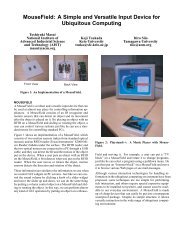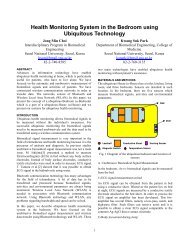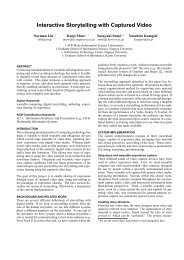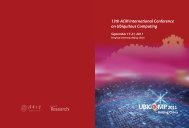Mobile phones within the range for a while are consideredto have similar behaviors and can form a cooperative cluster.We prefer Bluetooth because its prevalence on mobilephones. Bluetooth is a standard and communications protocolprimarily designed for low power consumption with ashort range in each device. It enables these devices to communicatewith each other when they are in range. Maximumpermitted power of about 2.5mW can cover an areaof circle with a radius of about 10 meters. Therefore, weuse Bluetooth to detect whether the mobile phones are in asame cooperative cluster or not. The request to keep in touchwith each other for a while guarantees the same direction ofmovement, and it does not make sense if mobile phones passby toward the contrary direction.After cooperative clusters have been divided, we predict thedirection of each cluster using the integrated informationgathered from members of the cluster. Suppose there aren members in a cluster in a time period t 1 to t p , indicatedby {M 1 ,M 2 , ..., M n }. We apply the HMM method introducedahead on each member M i separately to get a traceT i = {l (i)1 ,l(i) 2 , ..., l(i) p },i =1, 2, ..., n. We propose a TraceLeast Square (TLS) algorithm to find the optimized traceT c = {l (c)1 ,l(c) 2 , ..., l(c) p } of the cluster. TLS addresses tothe following optimization problem:arg minT cp∑∑ n(l (c)ji=1 j=1− l (i)j )2 +p∑(l (c)jj=2− l (c)j−1 )2 (1)The first term penalizes the discrepancy between T c and T i ,and the second term keeps T c as smooth as possible.However, this optimization is unsolvable due to p parametersin all. Consider the trace information is time dependable, webreak it into single time period and it is equivalent to:⎧⎨arg min l(c)j∑ ni=1 (l(c) j∑ ni=1 (l(c) j− l (i)j )2 if j =1⎩ arg min (c) l− l (i)j )2 +(l (c)j − l (c)j−1 )2 if j>1j(2)It can be explained that the location at t 1 is decided by alll1,i i =1, 2, ..., n, and the location at t j , 1 1 (3)All the members in a cluster can be represented by the traceT c . The work flow of the algorithm is prescribed in Fig.2.As mobile phones are not static, the clusters need to be updatedperiodically. Therefore, the overall algorithm is in acirculation.SIMULATION EXPERIMENTSTo evaluate the performance of cooperative localization, wemake a simulation experiment in an indoor environment. AWi-Fi wireless environment is established on the 3rd floor ofFigure 2. The work flow of cooperative localization.our academic building, with an area of about 30m × 15m.The whole layout of the test-bed is shown in Fig.3, and 5TENDA APs are deployed around. We choose the hallwayto simulate a street, and two persons take different mobilephones to represent the passengers. One mobile phone is anO2 Xda Atom Life smartphone and the other one is a NokiaN95, both with Bluetooth and Wi-Fi wireless cards.Figure 3. The whole layout of the test-bed.We design two different traces to simulate the traffic state.The first one is that these two persons go straight forwardside by side, as shown in Fig.4(a). The red line denotes theactual trace of the person with O2, and the blue one is withN95. As they are always in the Bluetooth range, they areconsidered to be in a cluster. We apply our cooperative localizationto track each one separately and the cluster also.The tracking traces and the cluster trace are illustrated inFig.4(b). It is obvious that the tracking traces got by one mobilephone separately are quite fluctuant, although we havegiven geographic constraints in the HMM models. However,the cluster trace reflects a more smooth trace that representsthe overall trend of members. It can be inferred that our cooperativelocalization can catch a group of traffic objects thathave similar behaviors.The second trace we design is one person (with N95) turnsinto a room halfway as shown in Fig.5(a). After they get32
(a) Actual traces.(a) Actual traces.101099Y Coordinate (unit: m)8765Y Coordinate (unit: m)87654O2N95Cluster30 4 8 12 16 20 24 28 32X Coordinate (unit: m)(b) Tracking traces and cluster trace.4O2N95Cluster30 4 8 12 16 20 24 28 32X Coordinate (unit: m)(b) Tracking traces and cluster trace.Figure 4. Two persons go straight forward side by side.Figure 5. One person turns apart halfway.apart from each other, the Bluetooth signals are blocked bythe wall and these two mobile phones can not get in touchagain. Figure 5(b) presents the tracking result of this trace.Each single trace is still rough due to the noisy signals whilethe cluster trace is relatively smooth. Moreover, as the twophones exceed the range of Bluetooth, the cluster is brokenup and the cluster trace stops at the turning point accordingly.It indicates that our cooperative localization can dividethe mobile phones into exact clusters, make sure themembers in a cluster have similar mobile trends.CONCLUSION AND FUTURE WORKIn this paper, we originally propose a new cooperative localizationtechnique in Wi-Fi based networks to learn trafficstate. Unlike the cooperative localization in robots and wirelesssensor networks, our cooperative localization makes useof collaboration of mobile phones to separate them into differentclusters. Then their behaviors can be represented bythe cluster trace. We simulate it in wireless environment andthe simulation results show the effectiveness. In the future,we will make actual traffic experiments and improvement onthe algorithms further.REFERENCES1. P. Bahl, A. Balachandran, and V. Padmanabhan. Enhancements to theradar user location and tracking system. 2000.2. E. S. Bhasker, S. W. Brown, and W. G. Griswold. Employing userfeedback for fast, accurate, low-maintenance geolocationing. InPERCOM ’04: Proceedings of the Second IEEE InternationalConference on Pervasive Computing and Communications(PerCom’04), page 111, Washington, DC, USA, 2004. IEEEComputer Society.3. F. Gustafsson, F. Gunnarsson, N. Bergman, U. Forssell, J. Jansson,R. Karlsson, and P. Nordlund. Particle filters for positioning,navigation, and tracking. 2002.4. A. M. Ladd, K. E. Bekris, A. Rudys, L. E. Kavraki, and D. S.Wallach. Robotics-based location sensing using wireless Ethernet.Wireless Networks, 11(1), 2005.5. C. L. F. Mayorga, F. D. Rosa, S. A. W. G. Simone, M. C. N. Raynal,J. Figueiras, and S. Frattasi. Cooperative positioning techniques formobile localization in 4g cellular networks. In Proceedings of IEEEInternational Conference on Pervasive Services (ICPS’07), 2007.6. L. M. Ni, Y. Liu, Y. C. Lau, and A. P. Patil. Landmarc: Indoorlocation sensing using active rfid. In PERCOM ’03: Proceedings ofthe First IEEE International Conference on Pervasive Computing andCommunications, page 407, Washington, DC, USA, 2003. IEEEComputer Society.7. L. R. Rabiner. A tutorial on hidden markov models and selectedapplications in speech recognition. pages 267–296, 1990.8. I. Rekleitis, G. Dudek, and E. Milios. Multi-robot collaboration forrobust exploration. Annals of Mathematics and Artificial Intelligence,31(1-4):7–40, 2001.9. T. Roos, P. Myllymaki, H. Tirri, P. Misikangas, , and J. Sievanen. Aprobabilistic approach to wlan user location estimation. In Intl J.Wireless Information Networks, vol. 9, no. 3, pp. 155-164, July, 2002.10. S. Y, R. W, and Z. Y. Localization from mere connectivity. InProceedings of the fourth ACM international symposium on Mobilead hoc networking and computing (MOBIHOC 2003),Annapolis,MD,USA, 2003.11. M. Youssef and A. Agrawala. The horus wlan location determinationsystem. In MobiSys ’05: Proceedings of the 3rd internationalconference on Mobile systems, applications, and services, pages205–218, New York, NY, USA, 2005. ACM.33
- Page 3 and 4: We would also like to extend a spec
- Page 5 and 6: ∙ USE‐03 Clinical Proof‐of‐
- Page 7 and 8: Ubiquitous Sustainability: Citizen
- Page 9 and 10: Devices that Alter Perception (DAP
- Page 11 and 12: incorporated into the body; if it d
- Page 13 and 14: vise. Beginning improvisers typical
- Page 15 and 16: Location-based Social Networking Sy
- Page 17 and 18: PrivacyWith any social networking a
- Page 19 and 20: BOXED EGO INSTALLATIONA pair of cam
- Page 21 and 22: the natural egocentric visuospatial
- Page 23 and 24: HUMAN SENSES AND ABSTRACT DANGERSOu
- Page 25 and 26: Gesture recognition as ubiquitous i
- Page 27 and 28: een developed to overcome this. For
- Page 29 and 30: 16. Myvu Corporation. Myvu Crystal.
- Page 31 and 32: especially in the fields of Ambient
- Page 33 and 34: 14. G. Riva (Editor), F. Vatalaro (
- Page 35 and 36: system, reflex arcs, and even muscl
- Page 37 and 38: 5. R. Cytowic. Synesthesia: Phenome
- Page 39: RELATED WORKLet us consider the loc
- Page 43 and 44: Figure 2. Schematic picture of the
- Page 45 and 46: notion of partial/total immersion w
- Page 47 and 48: A Quantitative Evaluation Model of
- Page 49 and 50: a group of users. We, therefore, in
- Page 51 and 52: During the above discussion, user g
- Page 53 and 54: Usability Study of Indoor Mobile Na
- Page 56 and 57: 11%3%0%0%30%19%5%3%0%11%56%Notifyed
- Page 58 and 59: CONCLUSIONFor this study, we have d
- Page 60 and 61: are suited to provide sufficient cl
- Page 62 and 63: attention to your blood pressure re
- Page 64 and 65: invested in final development and c
- Page 66 and 67: 4. rhythms - the highly predictable
- Page 68 and 69: technologies, especially their coll
- Page 70 and 71: Situvis: Visualising Multivariate C
- Page 72 and 73: all. A user selecting a range withi
- Page 74 and 75: constraints to include traces that
- Page 76 and 77: Simulation Framework in Second Life
- Page 78 and 79: VirtualEmitterEstimatedPositionVirt
- Page 80 and 81: odies) then our approach would faci
- Page 82 and 83: Design and Integration Principles f
- Page 84 and 85: asis for interaction, it focuses on
- Page 86 and 87: to support POST and GET messages as
- Page 88 and 89: senor node’s functionalities in a
- Page 90 and 91:
service model and provide paradigms
- Page 92 and 93:
Virtualization of resources will fa
- Page 94 and 95:
Figure 3. Heating and lighting cont
- Page 96 and 97:
sat down at the same time” can be
- Page 98 and 99:
10!; !< !=!"#$%&’"()%* +$(%,-’#
- Page 100 and 101:
posite event operators such as conj
- Page 102 and 103:
objects? If these particles were sm
- Page 104 and 105:
Over-the-air-programmingOTAP (Over-
- Page 106 and 107:
Randomised Collaborative Transmissi
- Page 108 and 109:
Figure 2. Illustration of periodic
- Page 110 and 111:
Figure 3. Illustration of the recei
- Page 112 and 113:
Experimental Wired Co-operation Arc
- Page 114 and 115:
The structure of network is matrix
- Page 116 and 117:
Altera Quartus II v7.2SP3 FPGA soft
- Page 118 and 119:
Using smart objects as the building
- Page 120 and 121:
To the ambient ecology concepts des
- Page 122 and 123:
event. A more complicated approach
- Page 124 and 125:
Multi-Tracker: Interactive Smart Ob
- Page 126 and 127:
interfacing with whole space, but c
- Page 128 and 129:
operate interactions by many partic
- Page 130 and 131:
An Augmented Book and Its Applicati
- Page 132 and 133:
its withy material. So, the movemen
- Page 134 and 135:
Table 1. The Performance of Page Fl
- Page 136 and 137:
Ambient Information SystemsWilliam
- Page 138 and 139:
We, too, believe there is a certain
- Page 140 and 141:
management system and forwarded to
- Page 142 and 143:
CONCLUSIONWe have presented the des
- Page 144 and 145:
Ambient interface design for a Mobi
- Page 146 and 147:
as ‘sensitive’ and filtered awa
- Page 148 and 149:
Ambient Life: Interrupted Permanent
- Page 150 and 151:
The log files revealed the actual r
- Page 152 and 153:
Stay-in-touch: a system for ambient
- Page 154 and 155:
Figure 1. The Stay-in-touch display
- Page 156 and 157:
User Generated Ambient PresenceGerm
- Page 158 and 159:
Figure 3: Cross-platform system tra
- Page 160 and 161:
The Invisible Display - Design Stra
- Page 162 and 163:
On a more general level Mimikry cre
- Page 164 and 165:
Rand in fact few examples of public
- Page 166 and 167:
Ambient Displays in Academic Settin
- Page 168 and 169:
usefulProfiles 22 (37%)Time and dat
- Page 170 and 171:
UTILIZE THE POTENTIAL TO FULLEST: D
- Page 172 and 173:
A notification system for a landmin
- Page 174 and 175:
As for the investigation phase, whe
- Page 176 and 177:
Ubiquitous Sustainability: Citizen
- Page 178 and 179:
Live Sustainability: A System for P
- Page 180 and 181:
(a) (b) (c)Figure 3. Screenshot for
- Page 182 and 183:
Motivating Sustainable BehaviorIan
- Page 184 and 185:
dialog with policy makers and servi
- Page 186 and 187:
5. Fogg, B. J. (2002). “Persuasiv
- Page 188 and 189:
on mode of transportation such as t
- Page 190 and 191:
In order to be useful, PET requires
- Page 192 and 193:
provides a relevant description and
- Page 194 and 195:
Star, L. S., The Ethnography of Inf
- Page 196 and 197:
door environment, the accuracy of G
- Page 198 and 199:
Figure 5. Variations of “Parasiti
- Page 200 and 201:
can view where it has been, who ans
- Page 202 and 203:
Nevermind UbiquityJeff BurkeCenter
- Page 204 and 205:
innovating within existing capacity
- Page 206 and 207:
Since the Brundlandt report a serie
- Page 208 and 209:
our current research in mobile gami
- Page 210 and 211:
conceive only of human-computer int
- Page 212 and 213:
human behaviour will encounter. The
- Page 214 and 215:
mental models of the world are test
- Page 216 and 217:
alternative, the place that could h
- Page 218 and 219:
elow the mode button indicate the c
- Page 220 and 221:
212
- Page 222 and 223:
digital collection of features to a
- Page 224 and 225:
immediately followed by a subset of
- Page 226 and 227:
forecast the future accesses to tho
- Page 228 and 229:
Enhanced and Continuously Connected
- Page 230 and 231:
than two application windows execut
- Page 232 and 233:
Secure and Dynamic Coordination ofH
- Page 234 and 235:
AudioProducer/ConsumerVideoConsumer
- Page 236 and 237:
228
- Page 238 and 239:
MotivationsMotivations occurred on
- Page 240:
Kray Christian ··········






